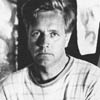Your shopping cart is empty!
Select currency
MENU

Peter Lanyon is identified most consistently as a landscape painter, yet he produced prints, made pots, murals and stained glass works, he created sculptures and constructions, and he taught. And in fact the term ‘landscape painter’ hardly does justice: as commonly understood, ‘landscape’ suggests natural forms, and works created by such an artist are often expected to canvas an arrangement of such forms into easily comprehended compositions. ‘Landscape’, for Peter Lanyon, meant more than natural forms: his paintings explore both the natural and the man made, the historical and the contemporary. And Peter Lanyon’s paintings are not conventionally composed, nor easily comprehended. Whilst their colours often make a direct reference to the land, their shapes are made semi-abstract or abstract, perspective might be head-on or from above, and content is not always easily discerned.
Peter Lanyon was born in St. Ives, Cornwall. After school he took painting lessons from Borlase Smart, a well respected art teacher and academic painter. He attended Penzance School of Art before moving to the Euston Road School of Art, London, where he was taught by Victor Pasmore. On his return to St. Ives he met Ben Nicholson, Barbara Hepworth and Naum Gabo - all three of whom had departed London to escape the war, and it was around these artists that the St. Ives School, with Peter Lanyon amongst them, would cohere.
Peter Lanyon’s first one-man exhibition was at the Gimpel Fils in London, 1949. Regular exhibitions there would follow in the fifties, and Peter Lanyon also participated in group shows with the Arts Council and the British Council. He sold little, however, and turned to teaching, first at the Bath Academy of Art, Wiltshire (1951-6) and from 1954 to 1960, with the help of Terry Frost and the painter William Redgrave, he set up a small art school: ‘St. Peter’s Loft’.
In the late fifties (1957) Peter Lanyon visited New York for an exhibition of his works at the Catherine Viviano Gallery. Subsequent exhibitions through the next decade would take place here, but in New York Peter Lanyon also met and befriended Mark Rothko and Robert Motherwell, both of whom would make visits to St. Ives. His work in England was at this juncture meeting with critical success: he won the Critics’ Prize in 1954; second prize in the John Moores exhibition (1959) and the Marzzotto acquisition award (1962), but actual sales were slow. All the more welcome, therefore, his relative success in the US, and sales there allowed Lanyon to pursue an interest in flying.
Peter Lanyon obtained his pilot licence and took up glider flying, and the paintings which resulted - his ‘gliding’ pictures - allude to the experience of looking down upon a patchwork of land below. He gained a more complete understanding of landscape, but his source of inspiration also become one of destruction as Peter Lanyon sustained critical injuries as a result of a flying accident, and at the age of only 46, on August 31st, 1964, he died.
Peter Lanyon’s work started to be recognized more widely in Britain in the 1980’s. He is now hailed as an innovator, particularly for his interdisciplinary approach to landscape painting. Peter Lanyon’s work is esteemed by private collectors, but his work can also be found in public collections: at the Tate; the Scottish National Gallery of Modern Art; the city of Birmingham Museum and Art Gallery, and the Whitworth Art Gallery, Manchester.
The Tate St. Ives; Scottish National Gallery of Modern Art; City of Birmingham Museum and Art Gallery; the Whitworth Art Gallery, Manchester.
This is a Limited Edition Giclee Print by the artist Peter Lanyon460mm x 360mmEdition size..
£115.00 Ex Tax: £95.83
This is a Limited Edition Giclee Print by the artist Peter Lanyon 240mm x 253mm E..
£115.00 Ex Tax: £95.83
This is a Limited Edition Giclee Print by the artist Peter Lanyon 245mm x 263mm E..
£115.00 Ex Tax: £95.83